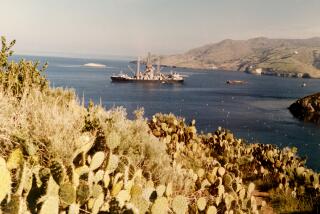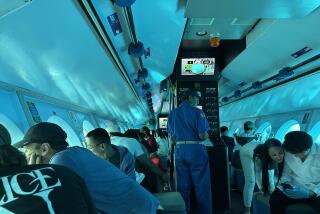Warm Welcome for Cold War Sub
- Share via
PROVIDENCE, R.I. — Ken Johnson folds himself through the tight passages of the K-77 with an ease born of familiarity.
But it’s a strange fit for the former U.S. Navy submariner, who served at a time when Soviet submarines like this one were the stuff of nightmares. A tense or even volatile encounter was always possible, and being inside one would have been unthinkable.
“I never dreamed that I would set foot on a Russian submarine,” said Johnson, 65, of Oakham, Mass., now a volunteer tour guide on the sub-turned-museum.
After years of targeting U.S. cities and ships, the K-77 floats placidly in Providence harbor, a short drive from the Statehouse and within sight of the massive fuel tanks that some worry could be targets for modern-day terrorists. As the Russian Sub Museum, the 282-foot diesel-powered sub opens its hatches to tourists and schoolchildren, many too young to remember the long-simmering conflict that it represents.
But the submarine’s very presence in Providence, not to mention the cluster of bunk beds for children staying aboard overnight and the room deep below the water line that’s used for birthday parties, would have seemed absurd at the height of the Cold War.
The K-77 was launched in 1965 as part of the Soviet Northern Fleet. Its class -- labeled the “Juliett” by the North Atlantic Treaty Organization -- was initially planned as a nuclear missile platform for strikes against the United States, particularly against East Coast cities.
Each sub carried four nuclear cruise missiles with a range of more than 300 miles, as well as an array of torpedoes.
When newer subs carrying more accurate cruise missiles were developed, the Juliett class took on a new mission: tracking U.S. aircraft carriers.
For the USS Saratoga Foundation -- the private, nonprofit group that owns the sub -- that relationship is fitting. The foundation is working to acquire the decommissioned aircraft carrier USS Saratoga and open it as a museum in Rhode Island.
“This sub and its cousins played cat and mouse with the Saratoga and its sisters,” said Bill Sheridan, deputy director of the foundation.
Although a number of decommissioned carriers are used as museums around the country, the foundation believes that it has an unusual opportunity to bring together two vessels that represented opposing sides of the conflict. The group eventually hopes to reunite the sub and the ship at Quonset Point in North Kingstown -- parallel floating museums teaching future generations about the rivalry between the two superpowers.
“We can now show the ying and yang of the Cold War by showing the two different technologies,” Sheridan said.
The foundation was formed to buy and preserve the Saratoga. But as that effort got bogged down, the foundation decided to acquire the sub -- known by NATO as Juliett 484 -- as a way to keep its volunteers involved and get experience running a museum.
The sub took a circuitous route to Rhode Island.
Decommissioned between 1991 and 1994, the K-77 was first purchased by Finnish businessman Jari Komulainen, who opened it as a restaurant and vodka bar in Helsinki.
Rooms of batteries used to power the sub were removed to make room for food preparation and seating areas.
But the floating restaurant and bar was a flop, and in 1998, he loaned it to a Canadian promoter who towed it to Florida. Plans to develop it as a tourist attraction there foundered when the sub got stuck on a sandbar within sight of its intended dock. It was relocated to another site, but didn’t fare well there either.
Komulainen then tried to sell the submarine in an EBay auction, listing it at a starting price of $1 million.
It didn’t sell, but the auction drew the attention of Intermedia Film Equities Ltd., which chartered K-77 for $200,000 to shoot the 2002 film “K-19: The Widowmaker.” It was moved to a dry dock in Halifax, Nova Scotia, Canada, and doctored with fiberglass additions to make the K-77 resemble the larger nuclear sub K-19.
After filming was over, the company was required to help find a new home for the sub and tow it at least as far as New York, Sheridan said.
The foundation emerged as a buyer, although as a condition of the contract, it can’t reveal what it paid for the sub, which opened to the public in 2002.
Its visitors are a mix of naval enthusiasts and the curious. They get a chance to crawl through the hatches, peek into its cramped sonar, periscope and other instrument rooms, its tiny galley, and the narrow bunks tucked along corridors.
The attraction also has served to bring former adversaries together.
Last year, the foundation hosted about a dozen former members of the Soviet Navy -- including some who served aboard the K-77 -- as part of a conference on naval operations during the Cold War.
The Russian visitors were shown a series of artifacts recovered during the sub’s restoration, including a knife. One former Soviet submariner recalled a fellow sailor being disciplined for losing it.
Johnson, the tour guide, hopes to continue the relationship with his former rivals by visiting Russia for a submarine conference. He wonders how close he came to the K-77 during his own Navy days.
“I often think of that,” he said with a smile.
More to Read
Sign up for Essential California
The most important California stories and recommendations in your inbox every morning.
You may occasionally receive promotional content from the Los Angeles Times.












